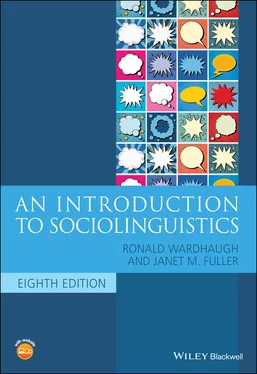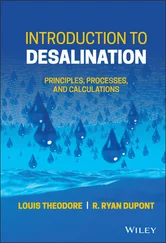Wolfram (2003) and Wolfram and Thomas (2002) take a slightly different position, favoring a neo‐Anglicist hypothesis that early African Americans maintained certain features of the languages they brought with them while at the same time accommodating to the local dialects of English. Wolfram and Thomas say that such a substrateinfluence (see chapter 9) from the African languages still persists in AAVE, certainly in the variety they examined in Hyde County, North Carolina. Wolfram and Torbert (2006, 228) claim that ‘AAE has diverged from European American varieties over the years, so that present‐day AAE is now quite different from contemporary benchmark European American dialects. The differences are not due to earlier language history, but to the everyday nature of African American speech during the twentieth century.’
Diametrically opposed to this view is the view of the creolists, for example, Stewart (1967), Dillard (1972), and Rickford (1977, 1997, 1999), who maintain that AAVE is of creole origin, and therefore a variety of English which originated quite independently of Standard English. (As we’ll discuss in more detail in chapter 9, creole languages are languages which develop in situations of language contact; in this case, contact between English‐speaking settlers and colonizers and speakers of West African languages who were brought to the Americas as slave.) In this view, AAVE has features that are typical of creole languages, particularly the zero copula and habitual be , some residual Africanisms, and certain styles of speaking (such as rapping, sounding, signifying, and fancy talk) which look back to an African origin. The claim is that AAVE is not a dialect of English but a creolized variety of English which continues to have profound differences from the standardized variety.
However, more recent research seeks to incorporate both of these views, noting that while settler varieties may have formed the basis for AAVE, there is also evidence of the influence from creole varieties such as Gullah and possibly Caribbean creole languages (Winford 2017). Mufwene (2014) also promotes a view which combines these influences, taking the position that the English‐origins position prevails, but this does not rule out contributions from creoles and African languages on the development of AAVE.
Societal aspects of AAVE use
Recent research on AAVE addresses its role in society along with the structural variation and change. Work on the role of AAVE in education has been of paramount importance (see Rickford et al. 2012), and the role of nonstandardized vernaculars and minoritized languages in schooling is a topic we will return to in chapter 12. Recent research has focused on both the importance of the home language for children in terms of their social identities and development as well as ways of integrating the home language into instruction in order to foster both learning and community building.
Other lines of research investigate the use of AAVE in various other institutions such as churches (DeBose 2015) and courtrooms (Rickford and King 2016; Slobe 2016), again addressing issues of community and social network as well as inequalities and identities.
The use of AAVE in the media has also become an important line of research, both because the use of the dialect in this public space has increased and because sociolinguistics are increasingly tuned in to the importance of all types of media use as part of our linguistic performances. These studies look at features of AAVE and how they are used in public performances such as hip‐hop music (Cutler 2008, 2010) or Twitter (Jones 2015). The occurrence of Mock AAVE (Smokoski 2016) or what has been called CRAAVE (cross‐race African American Vernacular English) by Bucholtz (1999) is also addressed, showing that AAVE is used to construct specific types of identities, drawing on essentialized ideas about violent and physically tough Black masculinity, as in Bucholtz’s work, or Black women as ‘fierce’ and ‘sassy,’ as in a study on the use of AAVE by gay British men (Ilbury 2020). As we will discuss further in chapter 7, the use of particular linguistic features is often part of stances and the construction of identities in interaction.
This brief overview of research on AAVE has raised two broad issues that we will continue to deal with throughout this text. First, language varieties are often associated with particular social groups and as such are used to construct the social identities of speakers. Second, these associations are often essentialized and used to discriminate. In the following section, we will look at the processes through which linguistic features acquire social meanings.
Styles and Indexes: The Social Meanings of Linguistic Forms
In addition to different regional and social dialects, there are also features of language which are linked to what has been called style. Recent research has investigated the question of how certain linguistic features become ideologically linked to particular varieties, and also how these features and varieties are used to create stancesand construct social identities. While we will touch on this last point, this line of research will be developed more in chapter 7; our focus in this section is a discussion of the concepts involved in the study of the social meanings of linguistic forms.
A key concept in the understanding of stylistic variation is that of indexicality. An indexical relationship between a signand its meaning develops through co‐occurrence. The expression in English when there’s smoke there’s fire illustrates this. This phrase is usually used to mean that if there are rumors or accusations of wrongdoing, then they are probably true – the ‘smoke’ (rumors) would not appear if there was not ‘fire’ (actual wrongdoings). Thus smoke indexes fire. Another way of expressing indexical relationships is to say that an index ‘points to’ a particular entity or meaning. To use another nonlinguistic example, the occurrence of thunder indexes a storm – thus for instance in theater, the sound of thunder can be used to index (i.e., evoke for the audience) the presence of a storm (Johnstone 2016).
How is this relevant for language? Particular linguistic features can come to index speech styles, and these styles are linked to social identity categories. For instance, because the word pop to denote a soft drink such as Coke or 7‐Up is heard in certain regions of the US, while soda is used in others, the use of pop has come to evoke regional belonging (in the Midwestern US). This is true of all types of linguistic features, not just the lexicon – pronunciation, intonation, grammatical structures, or pragmatic and discourse strategies. We form associations between certain ways of speaking and the personas and social identities of language users.
However, it is important to note that exactly what social meanings are associated with particular ways of speaking may vary. This is exemplified in research on a style called ‘Mock White Girl’ (Slobe 2018). In all of the examples given, there are particular linguistic features which are used in all of the different Mock White Girl performances. One of these is uptalk, or raised intonation at the end of statements, another is the use of like as a quotative(e.g., I was like, no way! ) or focus particle(e.g., He was like, old ). While these features are often linked to particular personal characteristics (being blonde, liking Starbucks), the broader social meaning of being a White girl varies widely. In one context, the Mock White Girl features are used to link these ways of speaking to a childish person, in another to a perpetuator of everyday racism and microaggressions toward women of color, and in a third to trivialize the concerns of White girls. Thus while the linguistic features consistently index a social category, the ideological stance toward that category – and thus the social meaning of the use of the linguistic style – may vary. It should further be noted that these features have not been shown to be uniquely used by White females; thus the indexicality of these features is based on stereotyping.
Читать дальше




![Andrew Radford - Linguistics An Introduction [Second Edition]](/books/397851/andrew-radford-linguistics-an-introduction-second-thumb.webp)







